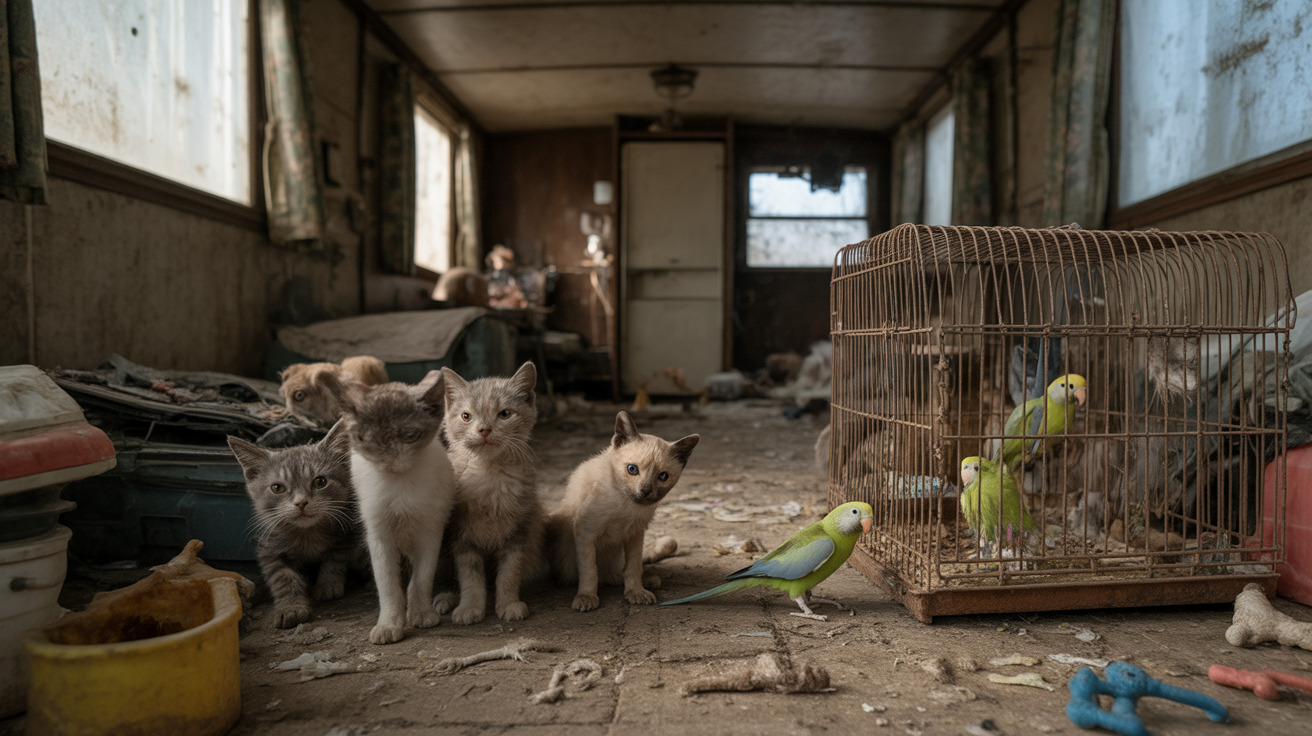Nash County Animal Services recently uncovered a disturbing animal neglect case in Castalia, North Carolina, removing at least 36 live animals from a mobile home along a secluded road. The ongoing investigation highlights the serious issue of animal hoarding signs that often go undetected until conditions become severe. This case serves as a stark reminder for pet parents and community members to recognize the warning signals of animal cruelty and neglect before situations reach crisis levels.
The rescue operation in Nash County reveals the complex nature of animal hoarding situations, where multiple species of animals were found living in unsuitable conditions. Animal control crews discovered not only cats and dogs but additional animals, indicating the scope of the hoarding problem. Such cases demonstrate how animal hoarding signs can escalate quickly when left unchecked, potentially endangering both animal welfare and human safety.
Understanding Animal Hoarding and Its Warning Signs
Animal hoarding represents a serious form of animal neglect that affects thousands of animals across North Carolina and the United States annually. Unlike responsible pet ownership, hoarding situations involve keeping more animals than can be properly cared for, resulting in deteriorating living conditions and compromised animal health.
The Nash County case exemplifies how animal hoarding statistics show these situations often involve multiple species and dozens of animals in confined spaces. Common animal hoarding signs include strong odors emanating from properties, visible accumulation of animal waste, animals appearing malnourished or sick, and properties showing signs of neglect or deterioration.
Animal Cruelty Investigation Process
When animal cruelty North Carolina cases emerge, authorities follow established protocols to ensure both animal and human safety. The investigation process typically involves multiple agencies working together to assess the situation, document conditions, and safely remove animals requiring immediate care.
In cases like the Nash County incident, animal control officers must carefully evaluate each animal's condition and determine appropriate placement. The animal cruelty investigation extends beyond immediate rescue efforts, often involving legal proceedings to address violations of animal cruelty law NC statutes.
The Connection Between Animal Hoarding and Human Welfare
Research consistently shows links between hoarding and child neglect, as living conditions that endanger animals often pose risks to human occupants as well. The animal hoarding mental health component cannot be overlooked, as these situations frequently involve individuals struggling with underlying psychological conditions that require professional intervention.
The community impact of animal hoarding extends beyond individual properties, affecting neighborhoods through health hazards, property values, and public safety concerns. Understanding these broader implications helps communities develop more effective animal hoarding prevention strategies.
Legal Consequences and Recovery Efforts
Animal hoarding legal consequences in North Carolina can include criminal charges, fines, and restrictions on future animal ownership. The state's animal cruelty law NC provides authorities with tools to prosecute offenders while prioritizing animal welfare and public safety.
Animal hoarding rehabilitation involves comprehensive approaches addressing both the animals' recovery needs and the underlying issues that created the hoarding situation. Many rescued animals require extensive veterinary care, behavioral rehabilitation, and careful placement in appropriate homes.
Prevention and Community Response
Effective animal hoarding prevention relies on community awareness and early intervention. Neighbors, family members, and community organizations play crucial roles in identifying animal neglect warning signs before situations become critical.
The animal rescue Nash County case demonstrates how coordinated community response can make the difference between life and death for vulnerable animals. When residents notice concerning conditions or behaviors, reporting to appropriate authorities enables timely intervention.
Frequently Asked Questions
What are the warning signs of animal hoarding in a home?
Key animal hoarding signs include strong odors from the property, numerous animals visible in windows or yards, accumulation of animal waste, animals appearing malnourished or unkempt, and deteriorating property conditions. Additionally, excessive animal sounds, unusual buying patterns of pet supplies, and social isolation of property occupants can indicate hoarding situations.
How do animal hoarding cases affect both pets and people?
Animal hoarding creates dangerous conditions for both animals and humans. Animals suffer from malnutrition, disease, and psychological stress due to overcrowding and poor sanitation. Humans face health risks from unsanitary conditions, potential zoonotic diseases, and structural damage to properties. The situation also creates emotional trauma and social isolation for those involved.
What should I do if I suspect animal cruelty or neglect in my neighborhood?
If you suspect animal cruelty or neglect, contact your local animal control services or sheriff's department immediately. Document what you observe with dates and times, but avoid confronting the property owner directly. Many areas have anonymous reporting systems that allow concerned citizens to report suspected animal welfare violations safely.
What happens to animals rescued from hoarding or neglect situations?
Rescued animals typically receive immediate veterinary evaluation and treatment for medical conditions. Depending on their health and behavioral status, animals may be placed in foster care, animal shelters, or specialized rehabilitation facilities. Many animals eventually become available for adoption after receiving appropriate care and behavioral assessment.
Moving Forward: Community Vigilance and Animal Welfare
The Nash County animal neglect case serves as a powerful reminder that animal welfare depends on community vigilance and prompt action when concerning situations arise. By understanding animal hoarding signs and supporting local animal control efforts, communities can prevent such tragedies and protect vulnerable animals from suffering.
As this investigation continues, it reinforces the importance of reporting suspected animal cruelty and supporting organizations dedicated to animal rescue and rehabilitation. Every community member has a role in ensuring animals receive the care and protection they deserve.






